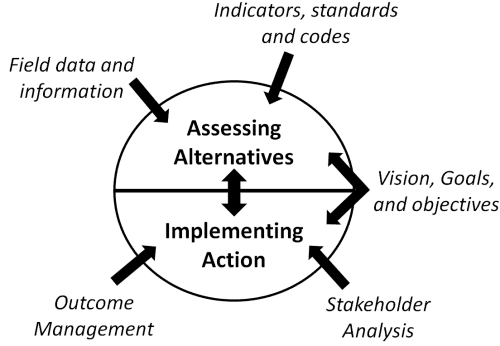
Environmental Decision-Making
Hari Srinivas Concept Note Series E-001. June 2015
Abstract
Environmental decision-making occurs at various levels, involving diverse stakeholders such as governments, businesses, and civil society. This concept note outlines the processes and principles guiding these decisions, emphasizing the need for integrated approaches that combine awareness, assessment, and action.It highlights the role of Sustainable Development Goals (SDGs) and Multilateral Environmental Agreements (MEAs) in shaping global environmental governance. Additionally, it introduces the GET Matrix, which frames decision-making through Governance, Education, and Technology at different scales. The note advocates for research-driven, participatory, and technologically enabled solutions to foster sustainable outcomes.
Keywords
environmental decisions, stakeholders, SDGs, MEAs, governance, education, technology, sustainability
cross the world, environmental decisions are constantly being taken. Their settings vary, as do the people and groups involved. Environmental decisions occur within neighbourhoods, small businesses, corporate boardrooms, and in the offices of local, state and national governments. They involve different people with different backgrounds. There is a constant need for understanding the various processes, actors and preconditions of decision-making processes for environmental management.
Environmental decisions anchor themselves on three entities - businesses, government, and the civil society at large. Facilitating interaction between them, and focussing on sustainable use of earth's resources, have been key challenges for developed and developing countries alike. What directions should research and development take? What specific roles should be played by the different actors so that innovation and creativity in environmental decisions can be fostered? How can environmental decision-making at various levels be supported and promoted?
Awareness, Assessment and Action
Good environmental decision making can be filtered down to two aspects Eassessing alternative options and implementing action.
Data taken from the filed, indicators, standards and codes, prevalent laws and regulations etc. Help in assessing alternative options to solving an environmental problem.
A thorough stakeholder analysis along with proper outcome management will help in implementing action to over come environmental problems.
Both the above two aspects are grounded with strong awareness of the what/why/how of environmental problems. This helps in developing a long-term vision, and broad goals and objectives that guide both assessments and actions.
It is clear that a culture of study, research and pedagogy needs to be developed, that is primarily focussed on the earth, and on man's environmental footprint. Environmental research needs to be geared towards mitigating current problems, and securing the earth for future generations. What changes, modifications and adjustments are necessary for a turn-around to refocus our efforts on sustainable lifestyles?
Research insights, monitoring and evaluation results, and information dialogues need to be incorporated into environmental projects, so that demonstrable successes can be an inspiration for further action and replication. What concrete steps should be taken? What is the nature of partnerships and networking that need to be put in place for sharing of knowledge gained?
Decisions for SDGs The Sustainable Development Goals (SDGs) serve as a global framework for guiding environmental decisions by integrating economic, social, and ecological considerations. By setting specific targets for issues such as climate action (SDG 13), clean water and sanitation (SDG 6), and responsible consumption and production (SDG 12), they provide clear objectives that influence policy formulation, corporate strategies, and community initiatives.
Governments align regulations with SDG targets, businesses adopt sustainability measures to comply with global expectations, and civil society organizations advocate for responsible environmental stewardship. The SDGs ensure that environmental decision-making incorporates long-term sustainability, fostering global collaboration and accountability.
Examples:
- A national carbon neutrality policy aligning with SDG 13 to reduce greenhouse gas emissions.
- A corporation adopting circular economy practices to fulfill SDG 12 on responsible production.
- A city implementing rainwater harvesting systems to achieve SDG 6 goals on water conservation.
Decisions for MEAs Multilateral Environmental Agreements (MEAs) play a crucial role in shaping environmental decision-making by establishing legally binding commitments among nations to address global challenges. Treaties such as the Paris Agreement, the Convention on Biological Diversity (CBD), and the Basel Convention on hazardous waste regulate international efforts and set compliance mechanisms for countries, businesses, and organizations.
These agreements guide domestic policies, technology adoption, and financial investments toward sustainable solutions. They also foster international cooperation by promoting knowledge sharing, capacity building, and equitable resource management, ensuring that environmental decisions align with globally recognized environmental norms.
Examples:
- A country implementing carbon pricing policies as part of its Paris Agreement commitments.
- A company adjusting supply chain policies to comply with the Basel Convention on hazardous waste.
- A local government expanding protected areas to meet CBD biodiversity conservation targets.
Decisions for the GET Matrix The GET Matrix provides a structured approach to understanding and improving environmental decision-making by examining the roles of Governance, Education, and Technology at global, national, and local levels. Governance ensures that environmental policies, regulations, and institutional frameworks are in place to guide actions. Education builds awareness and capacity among stakeholders, enabling informed choices. Technology drives innovation and efficiency in resource management and pollution control.
By analyzing environmental decisions within this matrix, stakeholders can identify gaps, synergies, and areas for policy intervention. The GET Matrix ensures that environmental decision-making is holistic, integrating regulatory mechanisms, knowledge dissemination, and technological advancements for sustainable outcomes.
Examples:
- Governance: A national government implementing carbon tax policies to regulate emissions.
- Education: A university introducing climate change courses to build awareness among students.
- Technology: A local municipality adopting AI-driven waste management systems for efficiency.
This GDRC programme combines alternatives, information, outcomes, and preferences to enable decision-makers achieve clarity of environmental action. The researh focusses on ways of breaking down a problem into manageable parts and explicitly considering all available courses of action. By systematically evaluating the implications of their decisions, decision-makers can clarify their actions, understanding what they should do, even with uncertainities.
This work by GDRC is licensed under a Creative Commons
Attribution-ShareAlike 4.0 International License. You are free to share and adapt this piece of work for your own purposes, as long as it is appropriately cited.
More info: http://creativecommons.org/licenses/by-sa/4.0/
on
| Environmental Decision-Making Contact:
|



